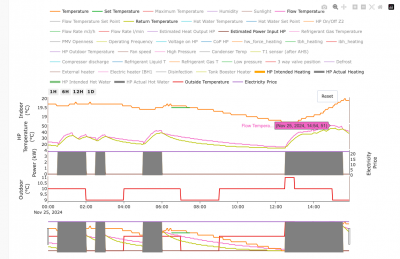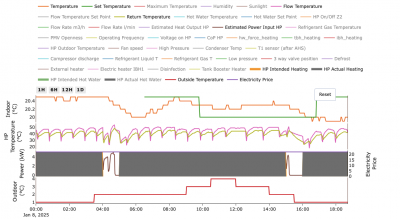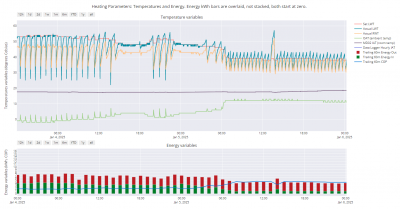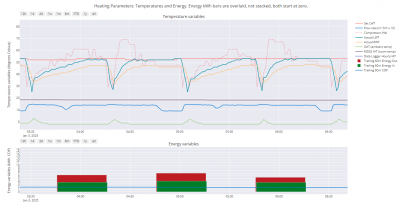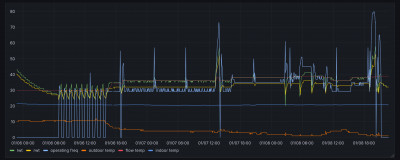@benson Mine is set roughly at 20.5 during day and 2 degree variance, with a roughly 2 degree lower temp for night time. There will always be dips occasionally but ours does a great job of providing consistent comfort. See this graph of the last 30 days mean home internal temp:
One zone, simple setup where the emitter size dictates that downstairs is always a bit warmer than up. We notice that the system takes about a day to respond to fairly sharp temp/weather changes, but we just leave it and everything catches up nicely. Have been toasty from day 2 after install until the present, two and a bit years later.
Midea 16kW ASHP, 15 rads and 4 underfloor circuits. Solar, batteries and Smart#1 EV with Hypervolt Home 3 Pro.
Homely smart control system, with additional modbus monitoring & installer app/web access. Techie and data nerd.
Host 424 on visitaheatpump.com: https://app.visitaheatpump.com/hosts/424
Thanks all. That is really useful. I've set it to 20.5 now (I've set it from 0600/0700 until 2200 so it will do a mild set back overnight), and will see how we get on. The house has generally been comfortable since installation so I agree that it seems to be a decent control system overall- if only we didn't have to go via the back door to get access to the dashboard.
Just to update on this, I did contact homely as it was just remaining at around 19.5 for more than a day or two, even though we had target set at 20.5. Their response was simply to manually increase the max flow temp back up to 50 their end with no other explanation. This is even though they had dealt with a previous query around it overshooting and simply throttled it back down to 46 to rectify that problem.
All in all their controls don't quite seem as sophisticated and self learning as they would like to make out. Do I need to continuously pester them to make seasonal adjustments?
@benson I'm assuming you've looked at radiator and/or UFH balancing? Especially if you've got the Freedom Midea/Samsung setup with hydraulic separation of your CH curcuit from the Heat Pump feed to/from the exchanger and three-port on the cylinder then it's important to know how your emitters are setup. I did find that I needed to 'tune' the rads and UFH balance at my home for a better consistent performance.
Do you have any particularly warm or cold areas in your home? If you do then that reinforces the need to look again at emitter balancing.
Midea 16kW ASHP, 15 rads and 4 underfloor circuits. Solar, batteries and Smart#1 EV with Hypervolt Home 3 Pro.
Homely smart control system, with additional modbus monitoring & installer app/web access. Techie and data nerd.
Host 424 on visitaheatpump.com: https://app.visitaheatpump.com/hosts/424
@el_presidente thanks yes balancing definitely needs to be completed. All our installers did was point an infrared thermometer at our radiators and announced they were all heating up to approximately the same temperature thus complete. What I don't quite get though is why the homely will coast along under the target temp without automatically adjusting max flow temp, or why it was firing up at 50 in much milder periods.
Regarding the balancing, any tips on how to do this? Is it just a case of making minor adjustments over a period of time to the lockshields to even out the temps in each room? We have no TRVs on the downstairs rads so I believe a permanent open loop being the design principle, with TRVs upstairs to make sure the bedrooms don't get too warm. I do have separate temperature sensors in the bedrooms now rather than relying on the ones in the smart TRV heads; thus these will presumably come in handy for this purpose and I have already opened up the lockshield a little bit more in one bedroom that was consistently half a degree colder and I could accurately measure changes etc.
Regarding hydraulic separation etc. I must admit that is beyond my current level of understanding and not something I have heard of before. It is a Clivet ASHP.
Posted by: @bensonWhat I don't quite get though is why the homely will coast along under the target temp without automatically adjusting max flow temp, or why it was firing up at 50 in much milder periods.
I think I am right in saying you have a Midea clone, possibly a Clivet? If so it might be useful if you can post a chart of your heat pump's behaviour of a period of a few hours sat 12 hours (short interval so we can see what happens during cycles) with at flow temp, return temp, set flow temp if available and flow rate, plus indoor and outdoor temps. These charts can be extremely useful in understanding what is going on.
Edit - just seen at the end of your last post you say you do have a Clivet!
Midea 14kW (for now...) ASHP heating both building and DHW
@cathoderay yes absolutely.
First one is back in Nov I believe on a milder day. You can see the flow temp going up to 50 and the indoor temp overshooting. No reason to do this as just set up on standard tariff and nowhere near cylinder reheat times so it definitely wasn't linked to that.
Second one from today.
COP is down to 2.58 today which I guess is to be expected as it is about as cold as it gets (or down south at least) and we do need reasonably high flow temps as our house isn't the greatest in terms of insulation.
@benson - very useful and interesting. What I think you are seeing is the Midea tendency to cycle all the time. I would be interesting to add the Flow temp set point (grey, first thing in second row of the legend which I don't think is on the charts). Most of the time, my Midea cycles, above and below the set point, with the mean flow temp being about where the set point is, but when it gets down to around zero and defrost cycles kick in, the mean flow temp falls well below the set flow temp.
Midea 14kW (for now...) ASHP heating both building and DHW
I posted this a few days ago on another thread, and shows the different set vs actual flow temp (LWT) behaviour depending on the OAT. The plots are done from data collected over modbus, I don't have Homely):
On the left, with a low OAT and defrost cycles, the LWT peaks at about the set LWT, and the mean LWT is a lot below the set LWT. In the middle there are two very unusual periods of steady state running. On the right hand side there is 'normal' cycling, with the mean LWT close to the set LWT.
If I zoom in during a cold spell (another plot previously posted elsewhere), it looks to me like the basic pattern is very similar to your cold spell plot, in other words this is probably largely Midea behaviour, not Homely behaviour.
Midea 14kW (for now...) ASHP heating both building and DHW
Hi from the Netherlands.
I have a Airwell Wellea Split (Midea clone) 8 kW heat pump and with these lower temperatures it is pretty stable. From 10 degrees and higher, the heat pump starts to cycle, sometimes more often than on other times. But at those temps the electricity usage per day is quite good.
The previous two winters with the heat pump, we had way more cycling, but that was due to our “smart” Tado thermostat, that does not understand how a heat pump works. I replaced the thermostat with a simple relay which I control using home assistant and from that moment, the heat pump cycles a lot less.
That is very enlightening- thank you.
I have had another look. Here's the data with the flow temp set point overlaid. I didn't realise you could toggle all the bits in the key above, on and off, on the homely dashboard. Thus as you say the actual flow temp is well under the actual set point for significant portions of the day.
@mosibi - I rather suspect the different style of plotting may be masking the fact that your plot does in fact show a similar, but perhaps marginally better heat pump behaviour. On the left, at moderate OATs of around 10 degrees, after the steady fall in LWT from 0000 to 0600 which I can't explain (heating off? By thermostat or timer?), we see typical Midea 'normal' cycling ie it is modulating output by cycling (it would be useful if you can add flow rate to the plot, I think you will find it remains pretty constant with brief dips in cycle with the the LWT cycles). At 1800 on 6th, the OAT drops to around 5 degrees, and your heat pump gets into its comfort zone, and remains in steady state until around 0300 on the 8th, apart from what looks like a DHW heating cycle at around noon on the 7th. At around 0300 on the 8th, the OAT drops further to just above zero, and your heat pump starts using defrost cycles, visible as such in the plot as the LWT drops below the RWT. Finally there is a brief period of steady state running as the OAT increases a bit, and then right at the end there is what looks like another DHW cycle and the heat starts to defrost again as the OAT falls. In 'normal' cycling and steady state running, your mean LWT is about where it should be, close to the set LWT, dut during the defrost cycles period, the mean LWT is probably a bit below your set LWT, being pulled down as it is by those deep defrost dips.
This seems to be the normal behaviour for Midea heat pumps, at least the ones whose owners have generously posted data, and very likely most Midea clones, perhaps with small variations. There is a small variable window at moderate to lower OATs where the heat pump runs at close to steady state. Above that window, it uses 'normal' cycling to modulate (reduce) its output, below that window it starts the robbing Peter to pay Paul dance (defrost cycles), and performance (COP) falls sharply (in my case it typically halves, from around 4 to around 2).
@benson - thanks for your latest plot. I think it also fits the above analysis for low OAT running. As far as I can see all those cycles are defrost cycles, and the drop in LWT during the defrost significantly pulls the mean actual LWT down below the set LWT.
I suspect that whether the indoor air temp drops during low OATs with attendant defrost cycling will depend on whether the heat pump can maintain enough output despite the negative impact of the defrosts. In my case, performance (COP) certainly falls dramatically, while at the same time the output does rise, but not enough to meet the increased heat loss at low OATs, and the indoor air temp inevitably falls. This can be seen in both the plots I posted recently. When the IAT is down to -2 degrees, the output (red bars on the lower charts) does increase, but not enough to meet the loss. At -2 degrees, my measured heat loss is around 8.6kW, but the heat pump only manages to put out a maximum of around 7.5 kW. Result: house cools.
Midea 14kW (for now...) ASHP heating both building and DHW
- 26 Forums
- 2,367 Topics
- 53.7 K Posts
- 212 Online
- 6,042 Members
Join Us!
Worth Watching
Latest Posts
-
Mitsu PUHZ-SW120YHA + EHSC-VM20Uk - Performance
I would appreciate any comments on the performance of m...
By DavidAlgarve , 39 minutes ago
-
Water Hammer After Heat Pump Install
Evening everyoneI have a very long story but to cut it ...
By JaynieQ , 12 hours ago
-
RE: Who's your electricity provider and what's your tariff?
@majordennisbloodnok This may be a better thread to ...
By Batpred , 15 hours ago
-
RE: Help needed with Grant Aerona 3 issues
Noted. Its a pity you didnt capture the flow rate and ...
By JamesPa , 20 hours ago
-

RE: Best Heat Pump Brand in the UK
Last Call to Vote & Win! Haven't voted for your Hea...
By Mars , 20 hours ago
-

RE: Solis S6-EH1P8K-L-PLUS – Why I Chose It and What I’ve Learned So Far
Interesting question. To be frank, since I have no inte...
By Majordennisbloodnok , 1 day ago
-
RE: Changing from 4-port buffer to volumizer
@andy1618 see the very sage advice from @editor above. ...
By JamesPa , 2 days ago
-
RE: New Fogstar 15.5kWh upright solution
The video shows the JK balancer, but the connection of ...
By Batpred , 2 days ago
-
RE: Ecodan unable to hit legionella target temp - what's the consensus?
@9jwr9 Hi, yes this is the issue with every (stand alon...
By ASHP-BOBBA , 2 days ago
-
RE: Help me keep the faith with my air source heat pump installation
@adamk FWIW I managed unintentionally to 'coax' mine in...
By JamesPa , 2 days ago
-
RE: Octopus Cosy Heat Pump Owners & Discussion Thread
You are in essence right. Adia only works with selecte...
By JamesPa , 2 days ago
-

No, you haven’t missed out, @batpred. This thread’ll st...
By Majordennisbloodnok , 2 days ago
-

RE: Tesla Powerwall – More of a ‘Luxury’ Than an ROI Winner!
Also, though they weren’t prepared to match the price t...
By Toodles , 2 days ago
-
RE: How long will your energy contract last?
My INTELLI-FIX-12M-25-08-29 has less than 12 months to ...
By Batpred , 2 days ago
-

RE: GivEnergy 2025 forthcoming batteries and inverters
Then, perhaps @toodles , you should've made a submissio...
By Transparent , 2 days ago
-
RE: Balancing financial efficiency and comfort using the Octopus Cosy tariff
I am wondering if anyone with an EV could find the 7p/k...
By Batpred , 2 days ago
-
Possibly, but it would also reduce DeltaT across the em...
By JamesPa , 2 days ago
-

RE: ASHP sizing - value of Heat Transfer Coefficient
@cathoderay It was reminiscent of the BBC Open Universi...
By Toodles , 2 days ago
-



